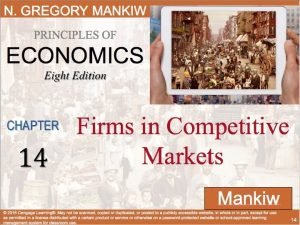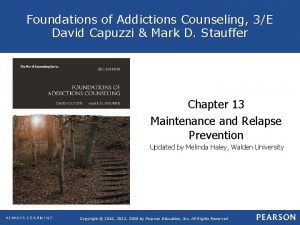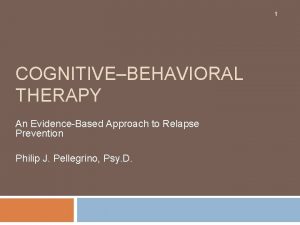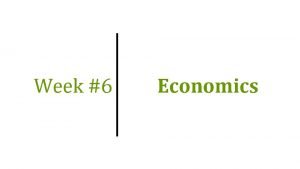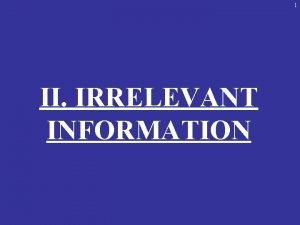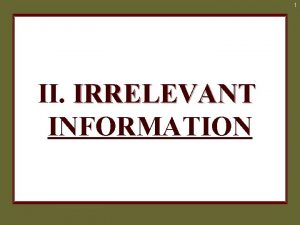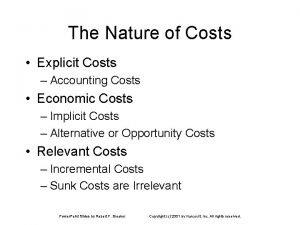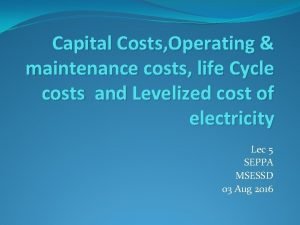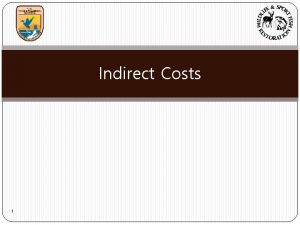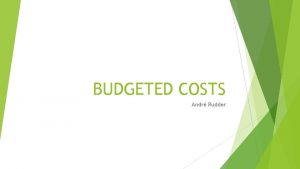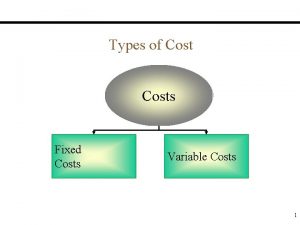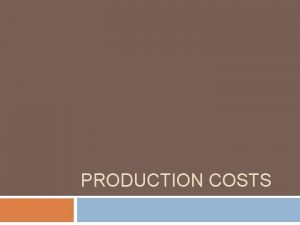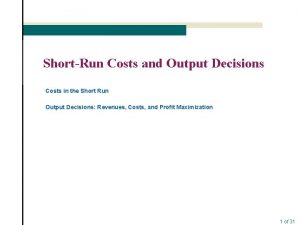Implicit costs are irrelevant for decisions in the














- Slides: 14


Implicit costs are irrelevant for decisions in the short run. A. True B. False

The short run is a period of time less than three months. A. True B. False

Explicit costs are input costs that require an outlay of money by the firm. A. True B. False

Chris owns ‘Christina’s bakery’ that currently has 2 workers. The first worker can produce 100 delicious baked goods in one day, and the second worker increased the total production by 80 delicious baked goods in one day. Chris is hiring a 3 rd worker. With three workers, what is the likely total production in one day? A. more than 180 but less than 260 delicious baked goods B. 300 delicious baked goods C. 180 delicious baked goods D. more than 100 but less than 180 delicious baked goods

Refer to the table. The marginal product from hiring the third worker is A. B. C. D. 88 units of output. 50 units of output. 16. 7 units of output. 12 units of output.

Alexander owns a small factory that makes fishing lures. He can make 10, 000 lures per year and sell them for $10 each. Alexander pays $25, 000 for raw materials to produce the 10, 000 lures. He invested a total of $20, 000 in equipment: $12, 000 of his own savings and $8, 000 borrowed at 10 percent interest. He could have earned 10 percent interest on his own money. Alexander could work at a competing factory for $40, 000. Alexander’s economic profit is _____, while his accounting profit is _____. A. B. C. D. $33, 000; $41, 200. $33, 000; $74, 200. $41, 200; $67, 000. $74, 200; $33, 200.

If the marginal cost curve is U-shaped and intersects the U-shaped average total cost curve at the minimum point on the average total cost curve, which of the following statements is correct? A. B. C. D. when the marginal cost curve is below the average cost curve, the marginal cost is increasing as more output is produced. when the marginal cost curve is below the average cost curve, the average total cost is decreasing as more output is produced. when the marginal cost curve is above the average total cost curve, the average total cost is decreasing as more output is produced. when the marginal cost curve is above the average cost curve, the marginal cost is decreasing as more output is produced.

Refer to the table. The marginal cost of producing the fifth unit of output is A. B. C. D. $8. $18. $40. $58.

Refer to the table. The total cost of producing five units of output is: A. B. C. D. $10 $19 $25. $50

Refer to the table. The average total cost of producing five units of output is A. B. C. D. $2. $5. $9. $45.

Which of the following is most likely to be a fixed cost in the short run? A. interest payments on funds borrowed by a farmer to finance farm machinery B. wages paid to workers who assemble computers C. performance bonuses for sales staff of a pharmaceutical company D. payments for gasoline for company cars driven by sales staff

Refer to the table. From zero to three units of labor, the production function exhibits A. increasing marginal product; the marginal cost curve would be downward sloping. B. increasing marginal product; the marginal cost curve would be upward sloping. C. decreasing marginal product; the marginal cost curve would be downward sloping. D. decreasing marginal product; the marginal cost curve would be upward sloping.

Which of the following is most likely to occur if a firm experiences coordination problems? A. diseconomies of scale B. economies of scale C. constant returns to scale D. specialization
 Meaning of poster making
Meaning of poster making Mikael ferm
Mikael ferm Sunk costs are irrelevant for decision making
Sunk costs are irrelevant for decision making Seemingly irrelevant decisions
Seemingly irrelevant decisions Seemingly irrelevant decisions in recovery
Seemingly irrelevant decisions in recovery Implicit costs
Implicit costs Screening decisions and preference decisions
Screening decisions and preference decisions Verksamhetsanalys exempel
Verksamhetsanalys exempel Frgar
Frgar Vilka tal pekar pilarna på
Vilka tal pekar pilarna på Tack för att ni har lyssnat
Tack för att ni har lyssnat Tidbok
Tidbok Treserva lathund
Treserva lathund Centrum för kunskap och säkerhet
Centrum för kunskap och säkerhet Formuö
Formuö


